KARMAPA LAMA
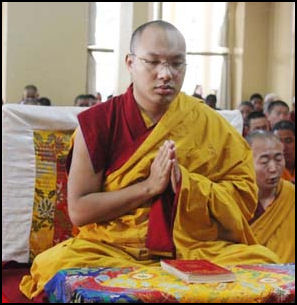
Karmapa Lama The Karmapa Lama is the third highest lama after the Dalai Lama and the Panchen Lama. He heads the Kagyu Karma, or the Black Hat sect — the oldest of Tibet's four allied schools of Buddhism. Karma Kagyupa is a suborder of the Kagyupa (Red Hat) sect. This is because the leader of the Karma Kagyupa, the Karmapa Lama, is often referred to as the Black-Hat Lama because that is the color of his ceremonial crown. Karma Kagyupa is Tibetan Buddhism’s wealthiest sect. It has property and assets worldwide worth $1.2 billion.
Karmapa means "one who performs the activity of a Buddha". The Karmapa wears an eight-inch-high crown woven from the hair of holy women. Kagyu Karma was the first Buddhist sect to adopt reincarnation as a means of choosing its leaders, and over the centuries bloody battles have taken place to choose who would ascend to the position of Karmapa.
The current incarnation is the 17th Karmapa. Two individuals have been declared the 17th Karmapa; Orgyen Trinley Dorje is generally and officially recognised as the official 17th Karmapa, however a rival Buddhist group give their allegiance to Trinlay Thaye Dorje. The son of a poor shepherd, Ugen Thinley Dorjee is the only high ranking lama in recent times who has been approved by both the Dalai Lama and the Chinese government. Approved by both in 1992, he was the subject of a German movie called "Living Buddha.”
Karmapa Ogyen Trinley Dorje was recognized by China before fleeing to join the Dalai Lama in exile in India in 2000 at age 14. His decision embarrassed Beijing but won him credibility among many Tibetans. Karmapa Ogyen Trinley Dorje has lived at Gyuto Ramoche Temple, the residence of the Karmapa. He has movie-star good looks and rubs shoulders with Richard Gere and Tom Cruise and is mentioned as a successor to the Dalai Lama. The Karmapa Lama is charismatic. He could play a major role determining the direction Tibet will take in the 21st century after the Dalai Lama dies. He could also play a roll unifying the Yellow Hat and Black Hat sects.
Good Websites and Sources: Official Karmpa site kagyuoffice.org/ ; Wikipedia article Wikipedia ; Karampa Info khandro.ne ; Rival Karmapa Lama karmapa.org ;
See Separate Articles: PANCHEN LAMA: HISTORY, STATUS AND THE 10TH ONE factsanddetails.com; PANCHEN LAMA CONTROVERSY: CHINA'S VERSUS THE DALAI LAMA'S PICK factsanddetails.com; DALAI LAMAS, THEIR HISTORY AND CHOOSING NEW ONES factsanddetails.com; PRESENT DALAI LAMA: EARLY LIFE, FAMILY AND TRAINING factsanddetails.com; Factsanddetails.com/China ; HISTORY OF TIBETAN BUDDHISM Factsanddetails.com/China ; TIBETAN BUDDHISM SECTS Factsanddetails.com/China
RECOMMENDED BOOKS: “The Heart Is Noble: Changing the World from the Inside Out” by The Seventeenth Karmapa and H.H. the Fourteenth Dalai Lama Amazon.com; “History of the Karmapas: The Odyssey of the Tibetan Masters with the Black Crown” by Lama Kunsang , Lama Pemo, et al. Amazon.com; “Karmapa: The Black Hat Lama of Tibet” by Nik Douglas and Meryl White Amazon.com
Lamas and Sects
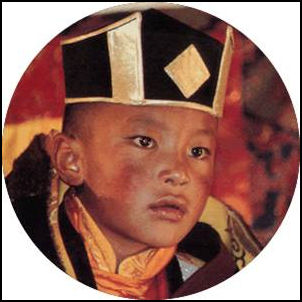
Karmapa Lama as a boy
The four main sects of Tibetan Buddhism are: 1) the Gelugpa (Yellow Hat) order, headed by the Dalai Lama; 2) the Kagyupa (Red Hat), order; 3) Nyingmapa order; and 4) the Sakyapa order. The Nyingmapa Order is the oldest, dating back to the 8th century. The Kagyupa (Red Hat) order and the Sakyapa order emerged around the same time in the 11th century. The Gelugpa (Yellow Hat) order emerged in the 15th century as a purer form of Buddhism at a time when the other sects were regarded as corrupt. It became the dominant sect in the 17th century.
The Gelugpa order are often called the Yellow Hats while the Kagyupa are called the Red Hats. The hats refer to the elaborate crescent-shaped hats worn by followers during ceremonies. The Chinese originated the terms to help them sort out the different sects in easy-to-remember terms, the same reason the terms are widely used by foreigners today. Sometimes the Red Hat term is used to describe all non-Yellow Hat sects
The term Black Hats refers to the Karma Kagyupa, a suborder of the Kagyupa (Red Hat) sect. This is because the leader of the Karma Kagyupa, the Karmapa Lama, is often referred to as the Black-Hat Lama because that is the color of his ceremonial crown..
Search for Latest Karmapa Lama
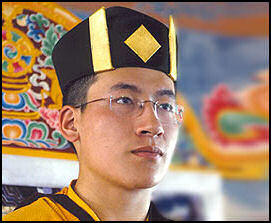
the other Karmapa Lama
The 16th Karmapa, a man named Ranjung Rigoe, died of cancer in Chicago in 1981, apparently without writing a traditional poem that would help his followers find his successor. For eight years followers looked through the Rumstek monetary in India for clues and found nothing.
Finally a regent and close friend of the Karmapa, Situ Rinpoche, decided to look in an amulet given to him by the Karmapa five years before he died. Inside was a poem that read that child would be found "to the north in the east of the land of snow [Tibet]/ A country where divine thunder spontaneously blazes [wordplay indicating a town]/ In a beautiful nomad's place with the sign of a cow. The [father] is Dondrub and the wisdom [mother] is Lolaga."
The “prediction letter” left in a locket of the previous Karmapa also contained Dorje’s birth year and correctly named his parents. According to members of the Kagyu sect, the boy persuaded his nomad parents to break camp early so they would be in the right place to meet the searchy party. Within a few months he was installed in the Karmapa’s Tsurphu monastery.
Life of Karmapa Lama
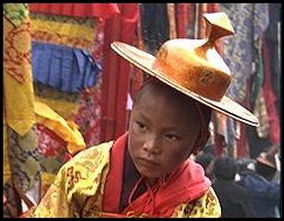
Karmapa Lama as a boy
Ugen Thinley was born in 1985 and was recognized as the Karmapa Lama at the age of seven. The eighth child in a nomadic family from the Lhathok district of Tibet, he displayed strange behavior as a child. Local people said he often vanished into the mountains, where he was fond of riding in the backs of goats and jackals.
Shortly after he was recognized the Karmapa Lama he was enthroned in a ceremony at the 12th century Tsurphu monastery in the Drowolung valley in central Tibet, 40 miles northwest of Lhasa. His training consisted mainly of studying Tibetan scriptures 10 hours a day.
Both the Dalai Lama and the Chinese government struggled to control the Karmapa's education. Several monks returned from exile in India to oversee the boy's education at Tsurphu monastery outside Lhasa. A fight between monks and officials broke out at the monastery after Chinese officials reportedly told the Karmapa bad things about the Dalai Lama.
Present Karmapa Lama and the Chinese Government
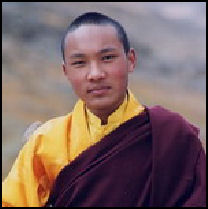
The 17th Karmapa was the first "Living Buddha" to be recognized by the atheist government of China. Beijing had hoped to groom him as a "patriotic" lama and wooed him with gifts such a color TV, a luxury Toyota 4500 and remote control cars which he liked to play with on the monastery roof. But at the same time the Karmapa was carefully watched at his monastery by uniformed security personnel. His mail was screened and he was not allowed to leave the monastery without permission.
The Karmapa Lama has refused to pay homage to the Panchen Lama and refused to read speeches prepared for him by party representatives. In 1995, when the 11-year-old boy met Chinese President Jiang Zemin, he allegedly said, "Who is this man?"
In late 1990s, the Karmapa Lama began losing patience with his Chinese overlords because they prevented him from visiting India, where he wanted to collect the hat that symbolized his authority, and bared his India-abased tutor, Situ Rinpoche, from visiting Tibet.
Assassination Attempt and Escape of the Karmapa Lama
In the summer of 1998, three intruders, reportedly Chinese, tried but failed to assassinate the 14-year Karmapa Lama at Tsurpha monastery. The intruders were hiding, with knives and explosives, under a blanket in the library of the main palace. The Karmapa reportedly had a bad omen and left the main palace before the assassins arrived. Afterwards security at Tsurphu monastery was increased with muscular monks in red robes frisking visitors and asking them to check in their knives and camera.
In December 1999, the 14-year-old Karmapa Lama fled from Tibet in a week-long journey across the Himalayas to Dharamsala, the home of the Dalai Lama. The odyssey began in late December when the Karmapa said that was entering his private apartment for an eight-day religious retreat and nobody was to bother him except his teacher and cook. He left during a time when he was being asked to denounce the Dalai Lama. [Source: Isabel Hilton, New York Times Magazine, May 12, 2000]
On December 28, the Karmapa changed from his maroon robes into pants, a down jacket, a warm hat, scarf and spectacles and climbed out his bedroom window onto the roof of a shrine and lowered himself and jumped from roof into waiting a Mitsuishi four-wheel drive vehicle. The Karmapa, two other lamas and driver drove 400 miles across Tibet to Nepal. Their first destination was the small Tibetan kingdom of Mustang in Nepal. They chose this destination because the road there had few checkpoints and the border itself was often unmanned.
Members of group had scouted the route and obtained business travel permits. The journey was relatively trouble free. The checkpoints were unmanned and the vehicle was not stopped once. As a precaution the Karmapa Lama slipped out of the vehicle where a military base was near the road, and hiked for five hours over mountains and rendezvoused with vehicle past the base. In Nepal, the group abandoned their vehicle and traveled through Mustang on horseback. They spent New Years Day in the shadow of the Annapurna range and were transported from a trekking lodge the next day in a helicopter to Kathmandu.
Karmapa Lama in India
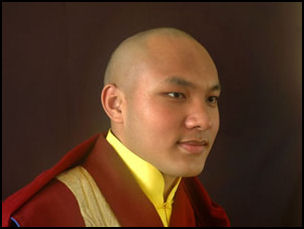
The Karmapa Lama and his group made their way from Kathmandu to India by taxi and train, arriving in Dharamsala on January 5. The entire journey from Lhasa to Dharamsala took eight days. About an hour after arriving the Karmapa Lama met with the Dalai Lama. One monk who witnessed the meeting told the New York Times, "It was a moment of great emotion. Leaving aside everything, they are two great boddhisatvas, an the understanding and affection between them are very moving."
The Karmapa Lama’s escape was a blow to Beijing, which had hoped to convert him to their side. In Lhasa, he left behind a note that said he was leaving to retrieve his crown and had no intention to "betray" the "motherland." In India, he and the Dalai Lama were asked to stay quiet and not do anything to anger Beijing. The fate of his cook and teacher is unknown.
The Karmapa Lama moved into a monastery on the outskirts of Dharamsala, where he is guarded by the Indian army. He hopes to go to Rumtek monastery and perform the traditional Black Crown ceremony with the crown he retrieved in India.
When he arrived in India, Indian intelligence thought he was a spy. He was restricted to the top floor of the monastery where he lived and was closely watched even when he prayed. The Karmapa told the Times of London, “Personally speaking, it doesn’t meet my expectations. Sometimes I feel a little bit like a prisoner... Like under house arrest.” Security measures were eased as he gained the trust of the Indian government and the Dalai Lama.
The Karmapa lives in a new monastery outside Bodh Gaya in Bihar in eastern India, where Buddha is said to have received enlightenment. He is watched over by three armed body guards. Visitors are frisked and forbidden from bringing cameras or cell phones. In 2009, about 10,000 people showed up to see him preside over the Monlam festival in Bihar.
Karmapa Lama Today

Ogyen Drodul Trinley Dorje is recognized by both the Dalai Lama and Beijing as the legitimate Karmapa. Twenty-three in 2009, he has shaved head and wears John-Lennon-style glasses. He is fond of America and likes his MacIntosh computer and play “war games” on his Sony Playstation to release “negative energy” and listens to hip hop on his iPod.
The Karmapa has a shaved and wears traditional robes but is regarded as handsome and even sexy. One American female fan has referred to him as “His Hotness” rather than “His Holiness.” The Karmapa speaks Chinese and Tibetan fluently, speaks pretty good English and is studying Korean. He also likes to paint and hang out with his sister.
The Karmapa Lama is regarded as stiffer and less jolly than the Dalai lama but has charisma and is considered self assured and a good listener. Like the Dalai Lama he aims to be a global figure that reaches not only Buddhists but members of all religions..
Lobsang Sangat, a senior fellow at Harvard Law School, told Newsweek. “He has grown up to be a very attractive lama to the general public but also, importantly, to the young. They can connect with him. He’s the same age. They know the hardships he went through to escape.” Tenzin Tsundue of the Tibetan Youth Congress echoed these sentiments. “Karmapa is passionate, he’s energetic. He has the respect of the youth. We will really need him.”
The Karmapa made his first overseas trip, to the United States in 2008. Th nervous Indian government didn’t allow him to travel outside of India until then,
Karmapa Lama and Politics
The Karmapa voices views similar to those of the Dalai Lama about nonviolence, compassion, peaceful resolution of the Tibetan problem, and more autonomy for Tibet and has talked about the ‘sheer frustration, the sheer sense of suffocation’ that Tibetans feel.”
He told the Times of London, “I wish to have no political responsibilities...Having a monk as head of state doesn’t qualify as a fully fledged democracy.” He told Time, “I have no goals, nor any ambitions to be of great influence. But if circumstances make a force for change, then I am a force for change.”
When asked about returning to Tibet, he told the Times of London, “I hope so, because I’m still young, maybe I have time.”
On the riots he told Newsweek, “When you feel the force of being cornered time and again, more and more, the time comes when you have nothing else left except to explode.” He told the Times of London, “All this could be a blessing in disguise. All the inspiration for the Tibetan struggle is coming from within Tibet.
He told the Washington Post, “The Chinese government considers the older generation of Tibetans as rubbish. What they are trying to value now is the coming-up generation. We must not consider China and the Chinese as opponents and enemies, but respect them as a source of education. We should learn their language. That’s how you become equal.”
The Karmapa Lama is hero among young Tibetans in the exile community. He is regarded as honest and able. In 2009 he sacked an administrator in Gangtok for corruption.
The Karmapa admitted to Newsweek that some communications takes place between him and the Chinese government . The main message from Beijing seems to be to stay out of politics.
Karmapa Lama and the Dalai Lama
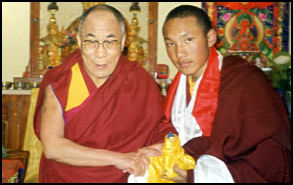
Some view the Karmapa as a potential replacement for the Dalai Lama and think he is being prepared as interim leader or regent to preside over the Tibetan community between the period when the present Dalai Lama dies and a new Dalai Lama is found. The Karmapa can not be a permanent replacement because he has already been reincarnated and comes from a different sect than the Dalai Lama.
The Karmapa has studied with the Dalai Lama and has spent a fair amount of time with him in Dharmasala, where he lives in a house near the Dalai Lama. The two spend a fair amount of time with each other. They have lunch together at least once a month, with the Dalai Lama often giving him a present such as sweets or prayer beads. Foreign visitors seeking an audience with the Dalai Lama often find the Karmapa Lama sitting in.
On the Dalai Lama he said, “His holiness has been very successful in laying the foundations for the Tibetan struggle. He has done a great job. Now it is time for the next generation to build on this and carry it forward.”
When asked if could replace the Dalai Lama, the Karmapa told Newsweek he is one of many possible heirs. “The Dalai Lama is like the sun. No matter how many stars there are, they don’t look too bright in comparison.” He suggested some kind of coalition, saying “if many stars come together the same strength and power and brilliance of the sun” can be achieved
Rival Karmapas
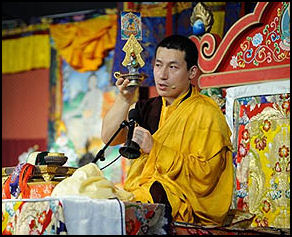
the other Karmapa
Before the 17th Karmapa Lama was selected a bitter feud broke out between people who believed that Ugen Thinley was the soul boy for the Karmapa Lama and those who believed a 10-year-old boy named Tenzin Chentse from New Delhi, India was the soul boy.
To back up their case, supporters of Ugen Thinley claim that clues from the regent’s poem point directly to him and that on the day of his birth, local people and lamas recalled, three suns appeared in the sky with a rainbow while unseen music from conch shells, flutes and cymbals appeared and a bird landed on the tent of his father and "sang a beautiful song." In addition, the Dalai Lama said he had dreams that indicated that the young boy was the future Karmapa.
Supporters of Tenzin Chentse claim that the poem in the amulet was a forgery placed there by the regent who found it. On their side are 300 monks and 400 "combat-ready" Europeans lead by a Danish ex-boxer ready to fight for Tenzin Chentse. Violent clashes broke out between the different factions in June 1992 at Rumtek monastery, requiring police to seal off the monastery.
Some still view Trinley Thaye Dorje — 26 in 2009 and also considers handsome and charismatic — as the true Karmapa. He left Tibet in 1994 and travels overseas and has a large following. He lives in Kalimpong, India and has received an education from English and Australian tutors and is regarded as less political than Trinley Dorje. He has studied Western philosophy and said in his website that his favorite group in Black Eyed Peas.
There has been reports of violence between his followers and those of Trinely Dorje. The Indian Supreme Court backed Trinely Dorje’s claim. The two claimants have never met face to face and go out of their way not to offend each other.
Karmapa Lama’s Tricky Relationship with India
India has serious doubts about the Karmapa Lama and not certain about what to do with him. Intelligence agencies are suspicious of his loyalties and skeptical of his miraculous escape. They wonder how such an important figure could slip so easily over the border and have interrogated him and tightly restricted his travel. [Source: Jim Yardley, New York Times, February 8, 2011]
The Karmapa Lama remains mostly confined to the mountainside monastery of a Tibetan sect different from his own. Indian officials have blocked him from taking ownership built by his predecessor in the Indian border region of Sikkim. until claims from rival Tibetan factions over the Karmapa Lama are resolved. Under these conditions, the Karmapa Lama said wanted his own monastery and his aides struck a deal to buy land in 2010.
Karmapa Lama Money Controversy
But the Karmapa’s quest for a monastery set off a national furor — fanned by Indian media that have tapped into growing public anxiety about Chinese intentions on their disputed border — after Indian police investigating the Karmapa discovered about $1 million in foreign currency at his residence, including more than $166,000 in Chinese currency. Some sourced accused him of being a Chinese spy plotting a monastic empire along the border. [Source: Jim Yardley, New York Times, February 8, 2011]
In January 2011, police officers apprehended two men at a highway checkpoint after discovering about $219,000 in Indian rupees inside their car — money they said had come from the Karmapa. The next day, the police raided the Gyuto Monastery and found boxes of cash from more than 20 countries, including China; officers arrested the financial officer overseeing the Karmapa’s charitable trust and continue to investigate the Karmapa himself. “He ran from China,” said P. L. Thakur, the police inspector general in Dharamsala. “Tibet is under China. Why and how has this currency come here? For what purpose? Why was it being kept there?”
The allegations, largely unsubstantiated, were widely repeated in major Hindi- and English-language media here, prompting aides and supporters to wonder who's fanning the negative publicity. "There's definitely been a witch hunt," Kate Saunders, a spokeswoman for the International Campaign for Tibet, told the Los Angeles Times.
More than 2,000 Tibetans marched to the Gyuto Ramoche Temple, the residence of the Karmapa Ogyen Trinley Dorje, to show their support for the man at the center of the allegations. "Long live his holiness Karmapa," monks and worshipers chanted, fingering prayer beads and holding aloft pictures of him with the Dalai Lama. [Source: Mark Magnier, Los Angeles Times, February 08, 2011]
Naresh Mathur, one of the Karmapa’s lawyers, said the money was from the devotees who for the past decade had come from around the world for the Karmapa’s blessing. By custom, they leave an offering, usually envelopes of cash; the Chinese renminbi, he said, are from Tibetans or other Chinese who have made a pilgrimage to Dharamsala. Mr. Mathur said the Karmapa’s aides were unable to deposit the money because they were awaiting a decision on their application — made several years ago — for government approval to accept foreign currency. In the interim, they say, the money is stored where the officers found it — in boxes kept in a dorm room shared by monks. Mr. Mathur also denied any suggestion that the land deal was secretive or illegal, and he said that it was the seller who demanded cash.
“We will be making changes,” said Deki Chungyalpa, a spokeswoman for the Karmapa. “Like hiring a professional accountant who is not a monk.”
Karmapa Lama Controversy and Relations with India
Jim Yardley wrote in the New York Times, Many Tibetans scoff at the spying allegations But the episode starkly exposes the precarious position of the Dalai Lama and the exiled movement of Tibetan Buddhism he has led since he fled China in 1959. The Tibetan cause depends heavily on Indian good will, particularly as China has intensified efforts to discredit and infiltrate their exile organization. [Source: Jim Yardley, New York Times, February 8, 2011]
“What Tibetans must address is the idea that Tibetans could be considered a security threat to India and not an asset,” said Tsering Shakya, a leading Tibet specialist. “But the idea that a boy at the age of 14 was selected as a covert agent by a foreign government to destabilize India — and the assumption the boy will assume leadership of the Tibetan movement and eventually work against India — is worthy of a cheap spy novel.”
For many Tibetans, the broader concern is about the future of the Tibetan movement itself. Tenzin Tsundue is a Tibetan activist who once unfurled a “Free Tibet” banner at an appearance by President Hu Jintao of China. He says India has always been a steadfast friend of Tibetans, providing a home for as many as 120,000 Tibetan refugees, yet now he worries its support may be wavering. “This country that we are so grateful to is alleging the Karmapa is a spy for China,” he said. “And we can’t understand that at all.”
Image Sources: Kagyuoffice com and Karmapa.org
Text Sources: New York Times, Washington Post, Los Angeles Times, Times of London, National Geographic, The New Yorker, Time, Newsweek, Reuters, AP, Lonely Planet Guides, Compton’s Encyclopedia and various books and other publications.
Last updated September 2022
